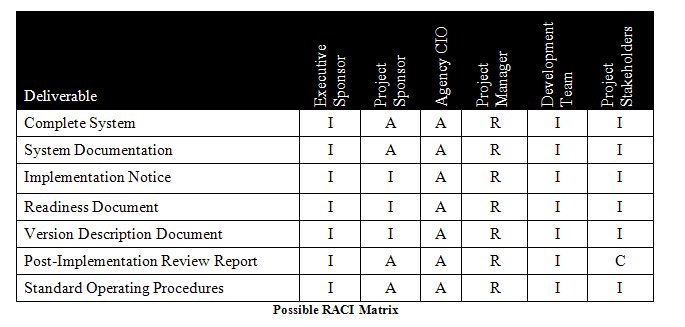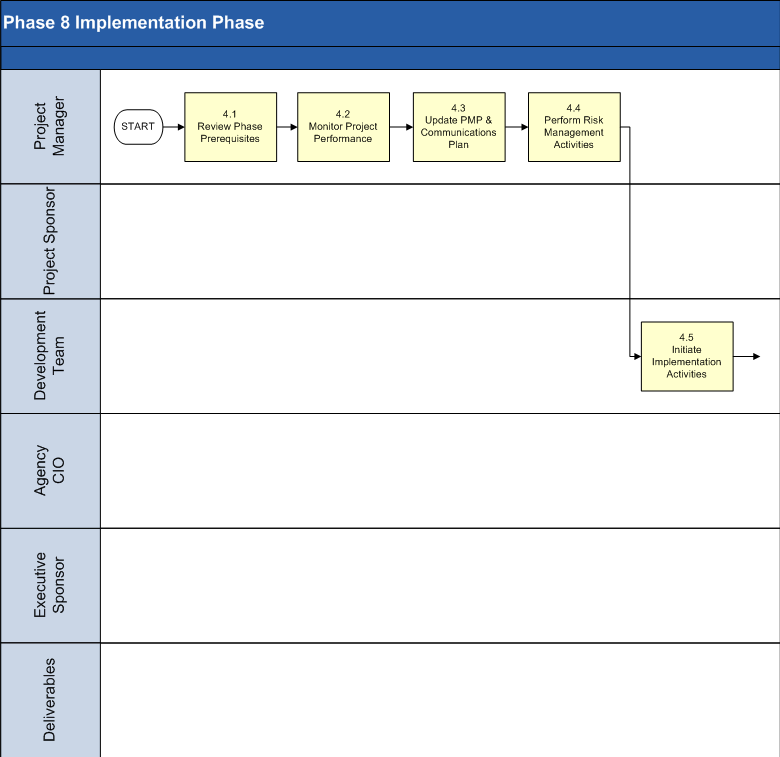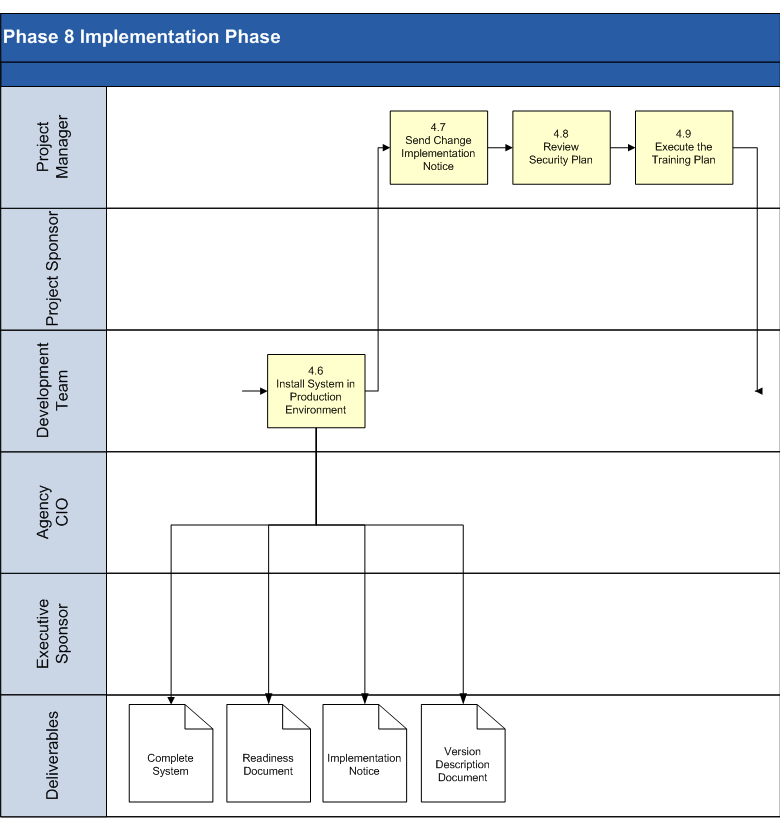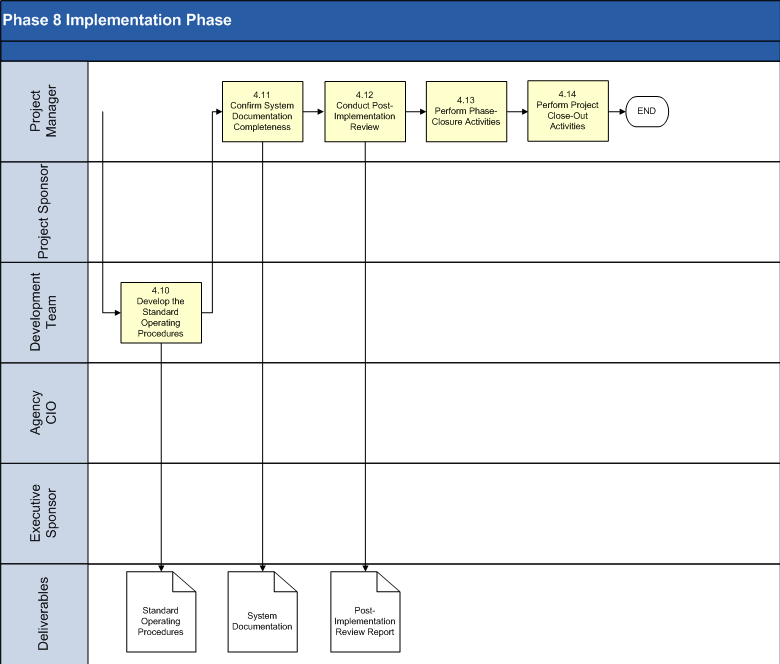The Implementation Phase has one key activity: installing the new system in its target environment. Supporting actions include training end-users and preparing to turn the system over to maintenance personnel. After this phase, the system enters the Operations and Maintenance Phase for the remainder of the system’s operational life. Multiple-release projects require multiple iterations of the Implementation Phase – one for each release.
Contents
1.0: Objectives / Goals
2.0: Deliverables and Approvals
3.0: Roles
4.0: Tasks and Activities
5.0: Conclusions
1.0 Objectives / Goals
Objectives
Successful completion of the Implementation Phase should comprise:
- System installation
- Training of end users on the system
Goals
The purpose of the Implementation Phase is to deploy and enable operations of the new information system in the production environment.
Back To Top
2.0 Deliverables and Approvals
SDLC deliverables help State agencies successfully plan, execute, and control IT projects by providing a framework to ensure that all aspects of the project are properly and consistently defined, planned, and communicated. The SDLC templates provide a clear structure of required content along with boilerplate language agencies may utilize and customize. State agencies may use formats other than the templates, as long as the deliverables include all required content.
The development and distribution of SDLC deliverables:
- Ensure common understanding among Development Team members and stakeholders,
- Serve as a reminder of specified plans as projects become increasingly complex,
- Provide agency senior management and other State officials insight into project risks and ongoing performance,
- Encourage the execution of repeatable and consistent processes,
- Facilitate the implementation of project management and agency IT best practices, and
- Result in a comprehensive record of project performance useful for many purposes (e.g. staff knowledge transfer, budgetary and other assessment activities, lessons learned).
During the development of documentation, the Development Team should:
- Write comprehensive, easy to understand documents with no redundant information.
- Develop an organized document repository for critical project information, so Development Team members can easily access, store, and reference project documents and other deliverables from all life cycle phases.
- Implement routine deliverable reviews to correct inaccuracy, incompleteness, and ambiguities.
- Recognize that sample templates for deliverables are available; agencies might accept deliverables in different formats as long as all required information is present. The content of these deliverables might expand or shrink depending on the size, scope, and complexity of the project.
- Recycle or reference information from earlier documents where possible and beneficial.
The following is a listing of deliverables required of all projects for this phase of work. Deliverables need to be updated for each iteration of the Implementation Phase.
|
Complete System – includes all code – modules, components, and libraries – kept in the production version of the data repository.
|
· Deliver system that meets the business need and all requirements
· Deploy system to production environment
|
Development Team
|
Agency CIO
|
|
System Documentation – includes all technical documentation delivered during the project (e.g. the SDD and the User Guide).
|
· Provide all documentation necessary to effectively operate and maintain the system
|
Development Team
|
Agency CIO
|
|
Implementation Notice – formally requests approval for system changes made during the Implementation Phase.
|
· Formally request approval for system implementation
|
Development Team
|
Agency CIO
Project Sponsor
|
|
Readiness Document – consolidates summary information regarding the current status of the system and the project and provides decision makers with the information necessary to make a “Go/No Go” decision. It should include a checklist listing all work products, User Acceptance Test (UAT) results, other indicators of success measures and deliverable acceptance.
|
· Provide information necessary to make the go/no-go decision
· Consolidate status information regarding the effective completion of the project and achievement of project objectives and SDLC requirements
· Affirm achievement of all deliverable acceptance criteria
|
Development Team
|
Agency CIO
|
|
Version Description Document – primary configuration control document used to track and control versions of software released to the operational environment. It also summarizes features and contents for the software build and identifies and describes the version of software delivered.
|
· Allow for tracking and control of software releases to the operational environment
· Document features and content in software builds
· Identify the version of the software being delivered
|
Development Team
|
Agency CIO
|
|
Post-Implementation Review Report – summarizes the assessment of Implementation activities at the end of the Implementation Phase.
|
· Summarize assessment of implementation activities
· Evaluate the effectiveness of the system development after the system has been in production
· Determine if the system does what it was designed to do
|
Project Manager
|
Agency CIO
Project Sponsor
Project Manager
Development Team
|
|
Standard Operating Procedures (SOP) (Optional) – defines in detail how the Systems Team will perform the business processes related to the operations and maintenance of the system. Whereas the User Guide is focused on the use of the system specifically, the SOP addresses all related business processes.
|
· Provide detailed instructions for future business processes
· Ensure consistent execution of business processes
· Drive performance improvement and improve organizational results
|
Development Team
|
Agency CIO
|
All deliverables other than those identified as Updates should be developed in this phase. Deliverables identified as Updates should be revisited and enhanced as necessary as prescribed in this phase.
Deliverables produced during this phase must be reviewed in detail and should follow the approval path as defined in the above table (for each iteration). A signature page or section should accompany each deliverable requiring approval. DoIT will periodically request copies of these documents as part of its oversight responsibilities.
Back To Top
3.0 Roles
The following personnel participate in the work activities during this phase:
- Agency CIO
- Project Sponsor
- Executive Sponsor
- Project Manager
- Development Team
- Project Stakeholders
|
RACI Key
|
|
Responsible – Describes role that executes the activities to achieve the task.
Accountable – Describes roles that own the quality of the deliverable and sign off on work that Responsible provides.
Consulted – Describes roles that provide subject matter expertise.
Informed – Describes roles that receive information about the task.
|

The Roles and Responsibilities page has detailed descriptions of these roles and their associated responsibilities.
Back To Top
4.0 Tasks and Activities



4.1 Review Phase Prerequisites.
The Project Manager ensures the following prerequisites for this phase are complete:
- The Project Management Plan is current, and the schedule showing the target termination date for the system is current.
- All testing is complete; the system has passed UAT.
- The Implementation Plan is complete and current.
- The Conversion Plan for legacy data and business processes is tested fully for accuracy and completeness.
- Training plans to train end users on proper system use are complete.
- The system documentation is complete and available.
- The system has completed Certification and Accreditation according to the DoIT guidelines.
4.2 Monitor Project Performance.
The Project Manager monitors project performance by gathering status information about:
- All changes to baseline data
- Change management information
- Activity progress with status details
- List of complete and incomplete deliverables
- Activities initiated and finished
- Quality assurance testing and test results
- Estimated time to completion
- Resource utilization data
- Changes to project scope
The Project Manager also organizes and oversees systematic quality assurance reviews of project work as a part of monitoring the project performance.
To measure project effort at all phases of the life cycle, the Project Manager establishes timelines and metrics for success at each phase of work when planning project tasks.
The PMBOK provides additional details on controlling project work in sections 4.4 and 4.5 and on project scope control in section 5.5.
4.3 Update PMP and Communication Management Plan.
The Project Manager updates the PMP routinely (at least quarterly) to ensure the PMP reflects project performance accurately. Review project performance controls and risks for deviations from the baseline.
Information dissemination is one of the most important responsibilities of the Project Manager. The Project Manager reviews and updates the Communication Management Plan at least quarterly to account for potential changes in project stakeholders. The Project Manager distributes the updated PMP and risk management information according to the revised Communication Management Plan. PMBOK Chapter 10 contains additional details on project communications and information distribution.
4.4 Perform Risk Management Activities.
The Project Manager conducts risk management activities during the Implementation Phase; these activities include:
- Identification – determination of risks that might affect the project and emerging risks as well as each risk characteristic
- Risk Analysis – conducting quantitative and/or qualitative analysis of each identified risk. Usually, qualitative risk management techniques are the most applicable for State projects. These risk analysis methods, as well as the conditions under which each method might be used, are described in detail in section 11 of PMBOK.
- Response Planning – planning of methods for developing mitigation, transfer, or avoidance strategies to reduce risk
- Monitoring and Control – tracking risks, monitoring residual risk, identifying new risks, executing response plans, and evaluating risk management effectiveness
These activities occur throughout the project duration to track and mitigate any new or changed project risks. PMBOK has details for risk management activities in section 11, particularly sections 11.2 through 11.6.
4.5 Initiate Implementation Activities.
The Development Team begins implementation with the following tasks:
- Selection of standards, methods, and tools for deploying the system
- Carrying out of Implementation Phase activities according to the detailed project WBS started during the Planning Phase. Implementation activities need to be performed for each release.
- Review of the change management process to ensure all Test Phase modifications have been documented
4.6 Install System in Production Environment.
The Development Team installs the system in the production environment. While installing the system, the Development Team should keep the configuration information updated by following the Configuration Management Plan defined in the Design Phase. The Development Team will repeat this activity for each iteration associated with a release to production.
4.7 Send the Change Implementation Notice.
The Project Manager sends the Change Implementation Notice to all end users and organizations affected by the implementation. In addition, the Project Manager informs those not directly affected by the implementation of possible disruptions to normal activity. The Change Implementation Notice includes the following:
- Implementation schedule
- Brief description of benefits of the new system
- Differences between the old and new system
- Responsibilities of end users during the Implementation Phase
- Instructions for contacting technical support, including contact names and phone numbers
The Development Team will repeat these activities for each iteration associated with a release to production.
4.8 Review the Security Plan.
The Project Manager reviews the Security Plan for required security policies and procedures during the Implementation Phase. Confirm that end users will receive training on DoIT security policies and procedures according to the Training Plan. All documents about security policies and procedures are available at the DoIT State Information Technology Security Policy and Standards Web page.
4.9 Execute the Training Plan.
The Project Manager oversees end user training on the new system. Use the previously designed training plan and the User Guide to train the end users effectively. Request end user feedback to determine if the training was effective. The Development Team will repeat these activities for each iteration associated with a release to production.
4.10 Develop the Standard Operating Procedures.
The Development Team may elect to develop SOP to provide documented and detailed instructions for performing all future business procedures associated with the system operations and maintenance. The SOP may reference procedures already documented in the User Guide, Operations Manual, Administration Manual, and Maintenance Manual. The SOP should focus on non-technical procedures necessary to execute future business processes. For multiple-release projects, the Development Team should develop the SOP as part of the first Implementation Phase iteration and then update the SOP for each additional release.
4.11 Confirm System Documentation Completeness.
The Project Manager reviews all system documentation to confirm that it is complete and correct. Review carefully the Operations Manual or System Administration Manual and User Guide to ensure they are ready for the Operations and Maintenance Phase.
4.12 Conduct Post-Implementation Review.
The Project Manager – with extensive input from the Agency CIO, Project Sponsor, Executive Sponsor, the Development Team, and key project stakeholders – conducts the Post-Implementation Review (PIR). Held after implementation is complete and the project effort is to be formally closed, the PIR is a formal evaluation of the actual level of project success. The PIR may also help agencies learn valuable lessons for future projects. The Development Team will conduct a formal Post-Implementation Review after the project’s final release to production. Interim reviews should be conducted after each release to identify lessons learned to utilize for future releases.
4.12.1 Review the project performance
Review the project performance to assess whether the project delivered promised benefits, met the agency project objectives, operated within scope, and produced the promised deliverables on time, within budget, and using the allocated resources. Assess how the project performed against each of the targets defined during the Initiation, Concept Development, and Planning phases. Identify whether the project:
- Delivered the business benefits described in the Business Case
- Achieved the objectives specified in the Project Charter and PSS
- Remained within the original scope
- Produced the necessary deliverables as defined in the WBS
- Met the quality targets defined in the Quality Management Plan
- Was completed within the planned project schedule
- Delivered within the budget defined in ITPR and any approved changes
4.12.2 Assess stakeholder satisfaction
Assess general stakeholder satisfaction and any perceived gaps that may require additional scrutiny.
4.12.3 Review the project conformance
Assess whether the project conformed to the management processes described in the project plans, and identify the extent to which the project has conformed to the nine project management knowledge areas of PMBOK:
- Time Management
- Cost Management
- Quality Management
- Change Management
- Risk Management
- Issue Management
- Procurement Management
- Acceptance Management
- Communications Management
4.12.4 Identify project achievements
List the major achievements for the project, and describe the positive effect of each achievement on the business.
4.12.5 Identify gaps in project fulfillment/project failures
List any project failures or gaps in promised functionality and describe their effect on the organization.
4.12.6 Identify lessons learned
Describe the lessons learned from undertaking this project, and list any recommendations for similar projects in the future.
If after the review the Project Manager finds the project’s implementation to be unacceptable, the Agency CIO may issue follow-up instructions and instruct the Project Manager to correct the deficiencies. If contractors completed the development, the Project Manager may determine that additional remediation work is within the scope of the statement of work or in the original contract.
4.13 Perform Phase-Closure Activities.
The Project Manager and the Development Team prepare and present a project status review for the Agency CIO, Project Sponsor, Executive Sponsor, and other project stakeholders after completing all Implementation Phase tasks. This review addresses the following:
- Status of Implementation Phase activities
- Planning status for operations and maintenance phases
- Status on resource availability for operations and maintenance
- "Go-No Go" decision made to proceed to next phase, based on Implementation Phase information
- Transfer system management responsibility to Systems Team personnel
The Project Manager compares actual project performance to the PMP and the projected cost of the project to determine any variances from the cost baseline during the phase-end review. The Project Manager also updates the Risk Register before beginning the next phase, Operations and Maintenance.
Document any end user requests for system changes to mitigate misunderstandings between end users and the Development Team. Review the Contracts Management checklist found with the Templates and Checklists area for unfinished contract tasks before closing out the Implementation Phase.
The Project Manager must obtain deliverable approval signatures before proceeding to the Operations and Maintenance Phase.
Update the project documentation repository upon completion of the phase-closure activities.
4.14 Perform Project Close-Out Activities.
The Project Manager closes the project and transitions the system to the agency Systems Team once the system is implemented in production and operates in a stable manner. Activities include:
- Transition of outstanding requirements to the Systems Team
- Disbanding of the Development Team and completion of team performance reviews
- Resolution of remaining contractor invoicing and contract compliance issues
- Close out of procurements
- Conducting of a lessons learned assessment of the project work to understand project difficulties and areas for improving future agency project work
- Obtaining of final project acceptance by the Project Sponsor
- Archiving of all relevant project documents as historical data. Refer to the Data Retention Plan completed in the Development Phase.
- Verification that all changes are conducted in accordance with the approved Change Management Plan
Back To Top
5.0 Conclusions
When the Implementation Phase concludes, the system begins operating and continues to do so until the organization determines it has outlived its usefulness and starts planning for a replacement system. The approval of the Implementation Phase deliverables and the completion of the Implementation project status review, and the execution of project close-out activities, signify the end of the Implementation Phase.